Unwind in Your Own Private Garden Escape
Most of us have a mental go-to place — somewhere we've been that gives us a sense of relaxation and security. Imagining ourselves there can help us regroup in the middle of a hectic day. Some of the most successful and productive people in our society have learned the secret of taking five-minute mental vacations when the daily grind seems to inundate them with tasks and stressors.
My mental go-to place is an overlook near Grandfather Mountain in western North Carolina. It's a wonderful place of escape. Stress disappears as I make my way over a footbridge and between boulders as tall as three-story buildings. Water trickles out of the mountain between the rocks, nurturing innumerable ferns and rhododendrons. A primordial mist and scents engulf me as I climb toward the peak. There I can sit and gaze out over countless mountains. I feel as though I can see forever. Lichens and a few brave rhododendrons that have taken hold in the cracks between the massive plates of rock are my companions. Life is put into perspective here.
You can design a personal garden space even in your corner of suburbia that authentically speaks to your go-to place and triggers those relaxing, pleasant memories. Regardless of how your place looks in your mind's eye, certain design principles will help you achieve that sense of relaxation and well-being you need and deserve. Your version of my mountain overlook can be waiting for you behind your garage or outside your kitchen door, just past the recycling bin and the electrical meter.
You know the place. Let's make it happen.
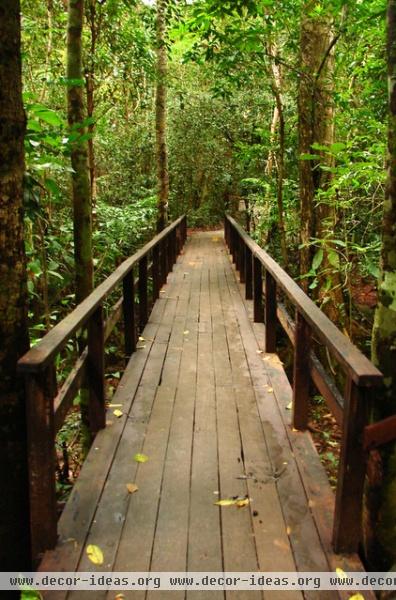
Create a transition to remind you to check your hectic day at the door. Every private garden needs an entrance. This gives a garden credibility and integrity, setting it apart from the outside world. An entrance could be a set of old doors, a trellis with a gate, stone pillars on either side of a pathway, a hidden opening in a tall hedge, a set of statues or a bridge.
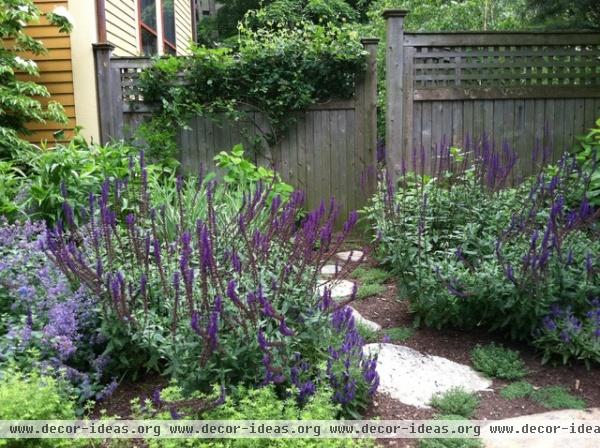
Don't you just want to slide between the opening in this fence and experience what's beyond? Perhaps a stone pillar or metal sculpture of Asian influence located to the left of the opening would welcome you home at the end of a long workday.
Whatever form your entryway takes, it's a reminder to leave your concerns at the door. Don't we all need those occasional reminders?
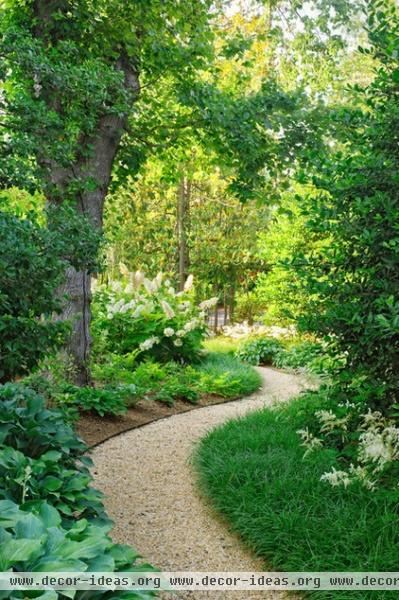
Less concrete. Go natural. After a day of work in the concrete and asphalt jungle, who needs to come home to more of that? To me, a go-to garden is all about people and plants, how they interact and coexist. Unless you have a good reason to use excessive hardscaping, why not use mulch or gravel instead?
Both are permeable, inexpensive and, most important, feel great under your feet. Mulch pathways cushion the feet and bring to mind the seemingly audible silence of a wilderness retreat. Gravel crunches underfoot, making the most delightful sound.
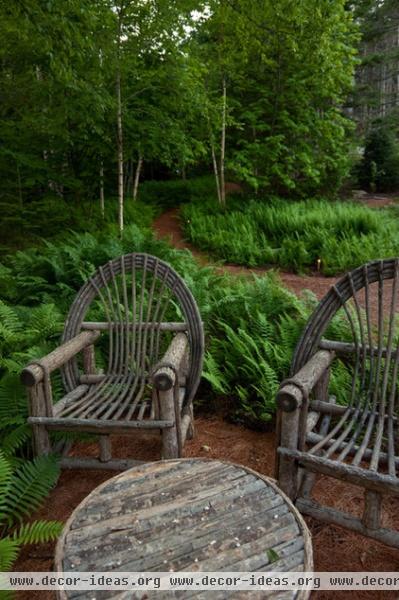
Use mass plantings to create flow. "Flow" is one of those words that is better felt than defined. This photo defines "flow" better than any dictionary ever could, and it feels right, doesn't it?
Using many plants of the same species creates unparalleled visual impact. A friend of mine told me that she would go to the nursery, spend $1,000 on one of this and one of that and never notice them again because they became visually engulfed by her large space. Together we planted 80 autumn ferns in a serpentine line around the back of her koi pond. She was astounded by the visual impact when she first stood back and saw the result.
The reason the concept of mass plantings works so well is that the eye flows uninterrupted, seeing the entire space as one element. The result is most assuredly a calm sense of relaxation.
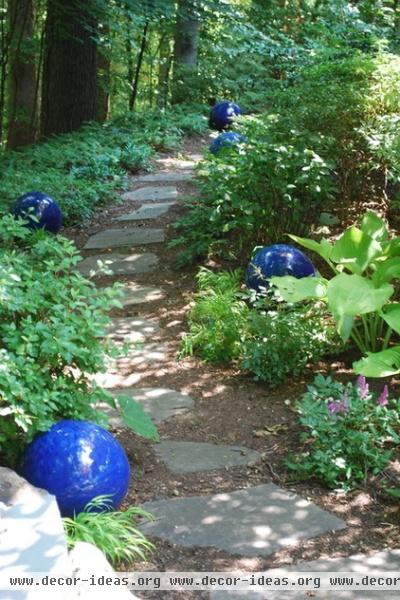
Establish rhythm in your garden. We all have an internal rhythm. Some of this is static, a part of who we are, and some of it changes according to our circumstances and moods. Heart and breathing rates are two of the most noticeable forms of internal rhythm, but your natural stride and style of walking and that melody that continually plays in your head are other forms of your own personal rhythm.
You can introduce the concept of rhythm in your garden by repeating certain key elements, as was done with these sculptural ceramic orbs. By spacing them farther apart, you can slow down your rhythm, creating a more leisurely garden experience. Closer spacing may actually decrease your sense of relaxation by making the space feel busier and more congested. Since these orbs alternate from side to side along this path, the eye is drawn down to a hidden part of the garden. Why? Because rhythm is established, and this rhythm resonates with your internal rhythm. If you've ever thought to yourself, "This garden speaks to me," rhythm is probably the reason.
Tip: When doing a rhythmic installation such as this, odd numbers of items are always more pleasing to the eye.
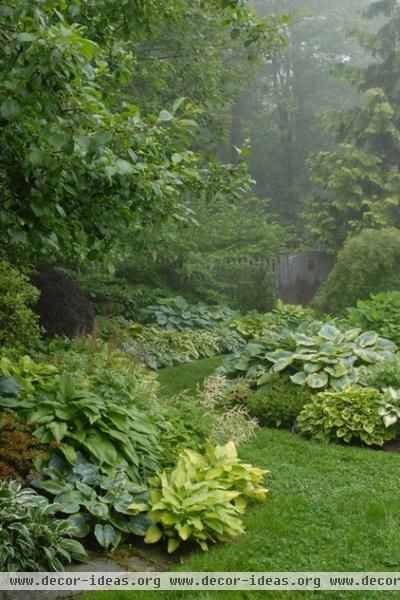
Use curved bed lines. While straight bed lines fit well into a formal garden, they can be much too rigid for your go-to space. Indeed, they may hinder your goal of relaxation unless your go-to space involves a queue, a theme park and a roller coaster. You will find that curved bed lines will calm you down and inspire a sense of well-being and creativity.
Another benefit of using curved bed lines is that they make it easier to transition from one type of planting to another. This way your plants won't end up looking like cans on a grocery store shelf.
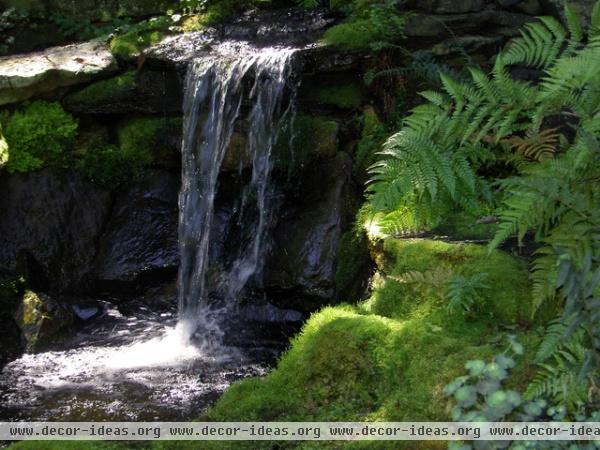
Introduce the element of water. Few things have captured the imagination of the human race like water. Water nourishes and sustains, reflects and absorbs light, and provides a home to a multitude of creatures, all of which are reasons to include some type of water element in almost every garden. The sound and movement of water bring a special degree of visceral animation to the garden.
The specific type of water feature you choose to incorporate into your personal space will vary according to your affinities, space and budget. You may choose a naturalistic type of pond like the one shown here, or even a trickle of water flowing through a piece of bamboo in a Japanese garden.
Tip: Consider having your water feature professionally designed, and buy the best equipment you can afford. There is nothing relaxing and nurturing about broken pumps, algae blooms and water leaks.
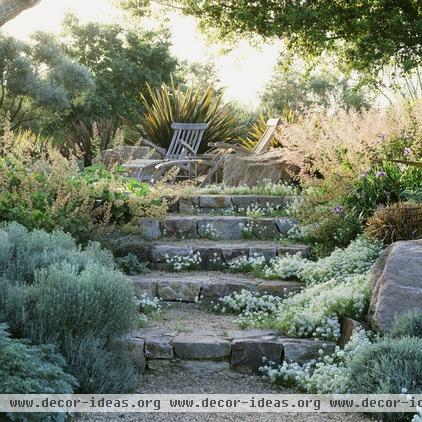
Refine your plant palette. Now on to the fun part. Creating a plant palette can be a daunting task for many gardeners, so here are some pointers.
Limit your colors but explore shapes and textures. Bright warm oranges and gaudy pinks may be overpowering in a relaxation garden. If you study the garden shown here, you will find that the color palette is extremely limited. The majority of plants used in this garden are either bluish gray or tan. Green is used to subtly weave continuity into this space and to give the eye a place to rest. Likewise, most of the plants are mounding with a few accents of spikes. This mounding form is reinforced by boulders.
What gives this garden a punch of interest is really the enormous variation in texture, from the rock steps and boulders to the various leaf textures. Limiting the color palette and shapes creates a sensory foundation of comfort so that the viewer is encouraged to explore the wonderful variety of textures.
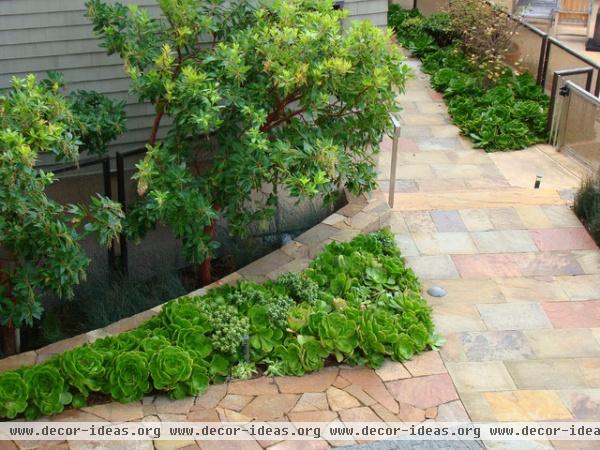
Similarly, the designer of this space significantly limited the color palette and even the plant shapes to give prominence to texture. You don't need a large space to pull this off; you could easily re-create the look on an apartment balcony.
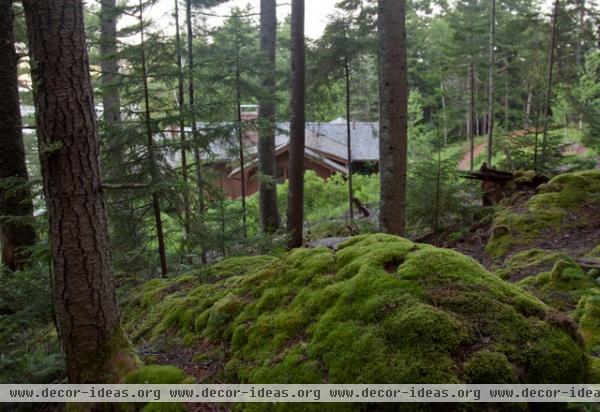
Consider the use of moss. I know of no other plant that so easily nurtures a sense of relaxation.
Moss can now be purchased by the square foot. Carefully research which type is best for your specific conditions. Some varieties can take more sun than others; some prefer sandy soil, while others prefer clay. Moss doesn't need perfect soil, but it does need daily watering until it is well established. The payoff is worth the extra effort on the front end.
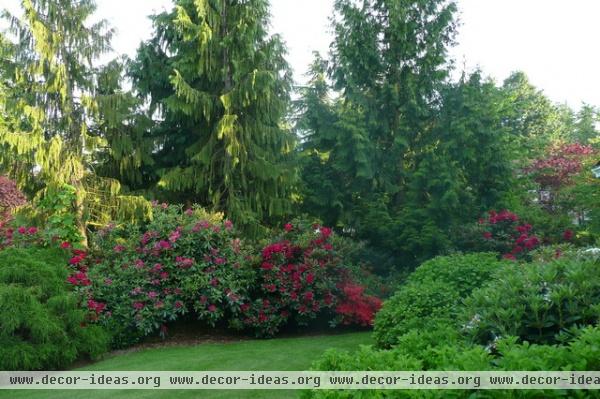
Add a weeping or pendulous tree. This may sound simplistic, but weeping and pendulous plants do help us feel relaxed, while upright spiky plants incite energy and activity. Picture yourself performing the relaxation technique of slowly breathing in and breathing out. Notice two things: the position of your body after you exhale and the accompanying feeling.
Weeping and pendulous trees imitate this form. Notice the wonderful pendulous Alaskan Cedar trees (chamaecyparis nootkatensis, zones 4 to 8) in the photo. Don't they lend a sense of calm to this garden space?












